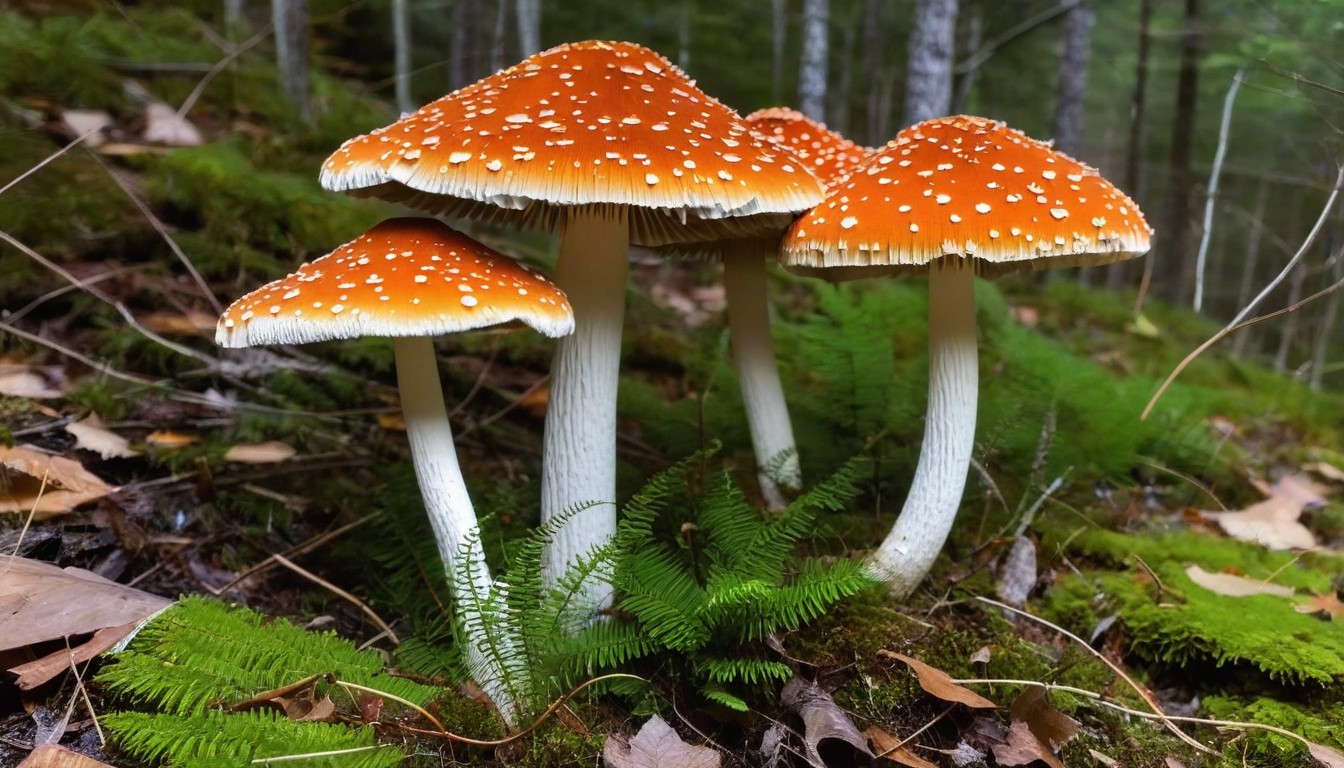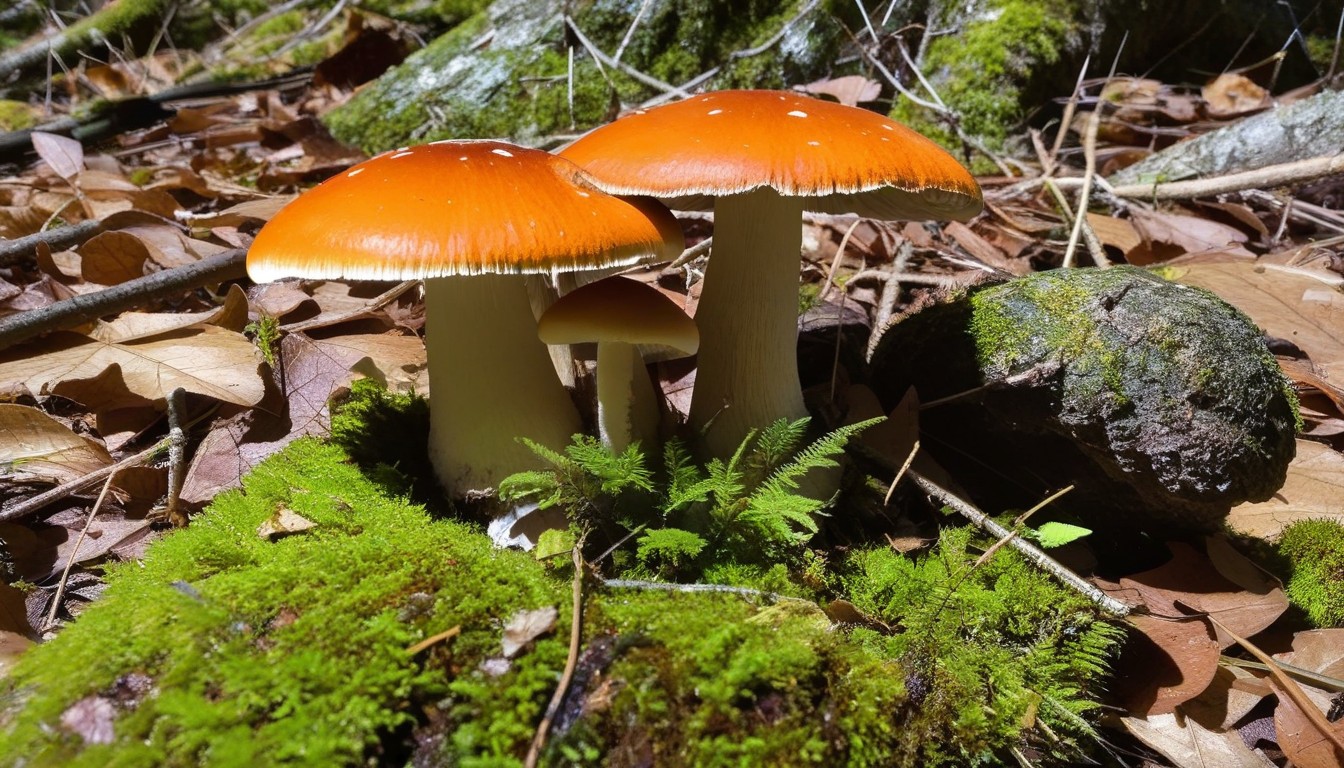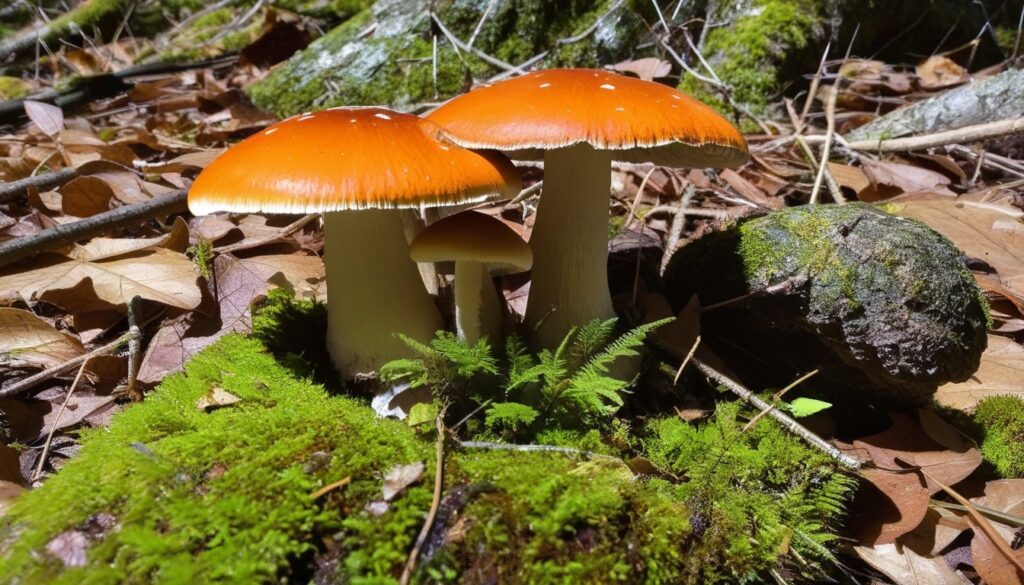Foraging for mushrooms in Maine can be a delightful and rewarding experience. However, it’s vital to exercise caution and proper identification to stay safe while exploring the wild. Knowing how to identify toxic species and recognize potential hazards can prevent serious health complications and make the trip more enjoyable.
Key Takeaways:
- Identifying poisonous mushrooms is crucial when foraging in the wild.
- Proper precautions can help avoid ingesting toxic species and ensure safety.
- Maine offers various resources for mushroom identification and safe foraging practices.
- If poisoning occurs, immediate medical attention is necessary.
- Following legal regulations and permits is essential for safe and responsible mushroom foraging.
Common Poisonous Mushrooms in Maine
Mushroom foraging in Maine can be a thrilling experience, but it’s important to be aware of the potential risks. There are several common poisonous mushrooms in Maine that should be avoided. Here, we’ll take a closer look at some of them:
Mushroom | Distinct Features | Potential Risks |
|---|---|---|
Death Cap | Glossy and greenish-yellow cap, white gills, and a bulbous base | Severe liver damage or death |
Destroying Angel | White gills and cap, with a sac-like base | Organ damage or death |
Jack O’Lantern | Orange or yellow gills, and a funnel-shaped cap | Severe gastrointestinal symptoms |
False Morel | Wrinkled and convoluted cap, with a spongy texture | Neurological symptoms and potential death |
It’s important to note that these are just a few examples of poisonous mushrooms found in Maine, and there are others that may also pose a risk. Always err on the side of caution and avoid consuming any mushroom if you’re not 100% confident in its identification.
Signs and Symptoms of Mushroom Poisoning

It’s essential to recognize the signs and symptoms of mushroom poisoning as early as possible, as time is of the essence when seeking treatment. Symptoms can vary depending on the type of mushroom ingested, but some common ones to look out for include:
- Stomach issues: Nausea, vomiting, and diarrhea can occur within hours of ingesting a poisonous mushroom.
- Neurological symptoms: Dizziness, confusion, and seizures can occur with some toxic mushrooms.
- Organ damage: Some mushrooms can cause liver or kidney damage, leading to jaundice, abdominal pain, and dark urine.
- Muscle weakness: Eating some toxic mushrooms can cause muscle weakness or paralysis.
If you or someone you know is experiencing any of these symptoms after eating a mushroom, seek medical attention immediately. It’s crucial to bring a sample of the mushroom ingested to assist the medical team in providing the appropriate treatment.
“Early recognition and diagnosis are essential to treating mushroom poisoning effectively.”
Edible Mushrooms in Maine
While it’s crucial to identify poisonous mushrooms in Maine, it’s also essential to know which mushrooms are safe to eat. Here are some of the most delicious and safe edible mushrooms to look for:
Mushroom Name | Description |
|---|---|
Chanterelles | A vibrant yellow-orange color, with wavy, trumpet-shaped caps. They have a fruity aroma and a delicate, buttery flavor. |
Morels | Conical shape, honeycomb-like cap, and can range in color from tan to gray. They have a nutty, meaty flavor. |
Red-orange color with a firm texture and meaty taste and smell reminiscent of seafood. | |
Hen of the Woods | A gray-brown color, with a large, leafy, and ruffled appearance. They have a strong, earthy flavor, resembling the taste of tender meat. |
When foraging for edible mushrooms, it’s important to be certain of their identification. Consult a field guide or other trusted resources to avoid mistaking them for poisonous species.
Precautions for Mushroom Foraging in Maine

Mushroom foraging in Maine can be a fun and rewarding activity, but it is not without risks. It’s essential to take precautions to ensure your safety while foraging in the wild. Here are some precautions to keep in mind:
- Proper identification: Always research and learn how to identify different mushroom species before you go mushroom foraging. Be cautious, as many poisonous mushrooms have similar-looking counterparts that are safe to eat.
- Equipment: Bring gloves, a knife, and a basket for collecting mushrooms. Avoid using plastic bags, as they can cause mushrooms to sweat and spoil.
- Best practices: It’s always a good idea to forage with a buddy, let someone know where you’re going, and bring a map or GPS device. Be respectful of the environment, and avoid disturbing plants and wildlife.
Following these precautions can help you stay safe while enjoying the unique experience of mushroom foraging in Maine.
Resources for Mushroom Identification in Maine

Identifying mushrooms in Maine can be a challenging task, especially for beginners. Luckily, there are many resources available that can help with mushroom identification.
Field Guides
The following field guides are some of the best resources for identifying mushrooms in Maine:
- Mushrooms of the Northeastern United States and Eastern Canada by Timothy J. Baroni
- Mushrooms and Other Fungi of North America by Roger Phillips
- The Complete Mushroom Hunter, Revised: Illustrated Guide to Foraging, Harvesting, and Enjoying Wild Mushrooms – Including new sections on growing your own incredible edibles and off-season collecting by Gary Lincoff
Online Databases
There are a variety of online databases available that can help with mushroom identification. Below are some of the best:
- Mushroom Observer – A database of mushroom images and observations
- MycoPortal – A database of North American fungi specimens
- iNaturalist – A platform for sharing nature observations, including mushrooms
Local Resources
There are also local resources available that can assist with mushroom identification in Maine, including:
- Mushroom Maineia – A website dedicated to the study and foraging of Maine mushrooms
- Maine Mycological Association – A community of mushroom enthusiasts in Maine that offers educational programs and forays
Poison Control and Treatment for Mushroom Poisoning
When dealing with mushroom poisoning, time is of the essence. If you suspect that someone has ingested a toxic mushroom, call your local poison control center immediately. They will ask for information about the person’s symptoms, the mushroom(s) involved, and any treatment already given. It’s essential to provide as much information as possible to ensure proper treatment.
While waiting for medical help, here are a few steps that can be taken:
- Remove any remaining pieces of mushroom from the victim’s mouth and/or hands
- Do not induce vomiting unless instructed to do so by poison control or a medical professional
- Monitor the person’s breathing, heart rate, and other vital signs
- Try to identify the mushroom(s) involved. This information can help medical professionals choose the appropriate treatment
The treatment for mushroom poisoning varies depending on the type and severity of the poisoning. In some cases, supportive care such as IV fluids, oxygen therapy, or medications to control symptoms may be all that’s needed. In other cases, hospitalization and more intensive treatments may be required.
If you or someone you know ingests a toxic mushroom, don’t hesitate to seek medical attention. Remember that prevention is the best cure, and proper identification is key to avoiding mushroom poisoning in the first place.
Legal Considerations for Mushroom Foraging in Maine

While foraging for mushrooms can be a delightful pastime, it’s important to be aware of any legal regulations or permits required in Maine.
The state of Maine does not require a permit or license to forage mushrooms for personal use. However, if you plan to sell any mushrooms, you must obtain a Wild Mushroom Harvester Certification from the Maine Department of Agriculture, Conservation, and Forestry. This ensures that any mushrooms sold are safe for consumption and collected sustainably.
It’s crucial to respect where and when you forage by adhering to any local regulations. Avoid private property without permission and designated conservation areas unless permitted. Additionally, it’s always important to pack out any trash and minimize your impact on the environment.
Taking the time to understand the legal considerations of mushroom foraging in Maine can enhance your experience and ensure that you comply with the law.
Conclusion
Foraging for mushrooms in Maine can be an exciting and rewarding experience, but it’s essential to stay safe and properly identify the species you encounter. By following the tips and guidelines provided in this article, you can minimize the risk of ingesting a toxic mushroom and enjoy the delicious edible varieties that Maine has to offer.
Remember to always be cautious while foraging in the wild, bring the necessary equipment, and take precautions to prevent harm. If you suspect you or someone else has ingested a toxic mushroom, seek medical attention immediately.
Overall, by respecting the environment and practicing safe and responsible mushroom foraging, you can fully enjoy the unique and bountiful wilderness of Maine.
FAQ
How can I identify poisonous mushrooms in Maine?
Identifying poisonous mushrooms in Maine can be challenging but crucial for your safety. Look for distinctive features such as brightly colored caps, unpleasant odors, or slimy textures. It’s best to consult a comprehensive field guide or seek guidance from experienced foragers before consuming any wild mushrooms.
What are some common poisonous mushrooms found in Maine?
Maine is home to several toxic mushroom species, including the deadly Amanita phalloides (Death Cap) and Amanita bisporigera (Destroying Angel). Other dangerous varieties include the Cortinarius orellanus (Fool’s Webcap) and Gyromitra esculenta (False Morel). It is vital to familiarize yourself with these mushrooms’ distinct features to avoid accidental ingestion.
What are the signs and symptoms of mushroom poisoning?
The signs and symptoms of mushroom poisoning vary depending on the specific toxins involved. Common symptoms include nausea, vomiting, abdominal pain, diarrhea, sweating, and hallucinations. In severe cases, liver and kidney damage can occur. If you suspect mushroom poisoning, seek immediate medical attention.
Are there edible mushrooms in Maine?
Yes, there are several delicious and safe-to-eat mushrooms in Maine. Some popular edible species include the Chanterelle, Lobster Mushroom, Morel, and Hen of the Woods. However, it is essential to accurately identify these mushrooms and ensure you are not mistaking them for their toxic counterparts.
What precautions should I take when foraging for mushrooms in Maine?
When foraging for mushrooms in Maine, take the following precautions: – Always bring a reliable field guide and consult experienced foragers. – Avoid consuming any mushroom unless you are 100% certain of its identity. – Use appropriate equipment, such as a mushroom knife or basket, to prevent cross-contamination. – Educate yourself on the specific habitats and seasons in which different mushrooms grow. – Practice sustainable foraging by only harvesting a limited amount and leaving some behind for ecosystem balance.
Are there any resources for mushroom identification in Maine?
Yes, several resources can help with mushroom identification in Maine. Local mycological societies often offer workshops and events where you can learn from experienced mushroom enthusiasts. Additionally, online databases and field guides specific to the region can be valuable tools in learning to identify mushrooms accurately.
What should I do if someone ingests a poisonous mushroom?
If someone ingests a poisonous mushroom, it is crucial to seek immediate medical help. Call your local poison control center or emergency services right away. Do not induce vomiting unless advised to do so by a medical professional. Provide as much information as possible about the mushroom ingested.
Are there any legal regulations or permits for mushroom foraging in Maine?
Currently, there are no specific legal regulations or permits required for mushroom foraging in Maine. However, it’s always a good idea to check with local authorities or park rangers to ensure you are following any guidelines or restrictions that may be in place.

